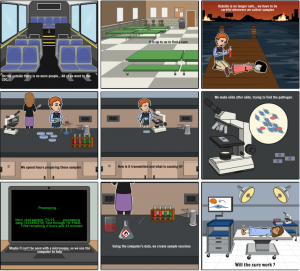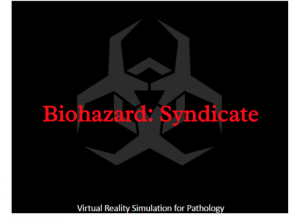Terris et Locis
Earth and Terrain
Roles and Responsibilities
- Project Manager/Lead Writer: Mike Katzenberger & Chris Colon
- Editor and Fact Checker: Zach DeLong, Kyle Rudman
- Technical Developer: Bryce Merkt, Seth Ava
- Learning Specialist: Haley Lennon
Sources
Annerstedt, Matilda, et al. “Inducing Physiological Stress Recovery With Sounds of Nature in a Virtual Reality Forest — Results From a Pilot Study.” vol 118, 2013, pp 240-250. ebscohost, http://www.sciencedirect.com/science/article/pii/S0031938413001650?via%3Dih ub. Accessed 25, Nov 2017.
Chau, Brian. “Hospital For Sick Kids Launches Virtual Reality Unit With Samsung.” IMedicalApps. 2017, ebscohost, www.imedicalapps.com/2017/04/hospital-for-sick-kids-virtual-reality/. Accessed 25, Nov 2017.
Cutillo, A, et al. “A Literature Review of Nature-Based Therapy and its Application in Cancer Care.” Journal of Therapeutic Horticulture. Vol. 25, no. 1, 2015, ebscohost, https://ezproxy.stevenson.edu/login?url=http://search.ebscohost.com/login.aspx?direct=true&db=a9h&AN=122818789&site=ehost-live. Accessed 25, Nov 2017.
Deans, Emily. “Nature Therapy.” Sussex Publishers. 2016, ebscohost, https://www.psychologytoday.com/blog/evolutionary-psychiatry/201608/nature-therapy. Accessed 27, Nov 2017.
Hart, Jane. “Prescribing Nature Therapy For Improved Mental Health.” Alternative & Complementary Therapies, vol. 22, no. 4, 2016, pp. 161-163. ebscohost, https://ezproxy.stevenson.edu/login?url=http://search.ebscohost.com/login.aspx?direct=true&db=a9h&AN=117300499&site=ehost-live. Accessed 25, Nov 2017.
“Journey With Us.” The Nature Conservancy. 2017, ebscohost, www.nature.org/how- we-work/virtual-reality-gallery.xml. Accessed 25, Nov 2017.
Lumsdaine, Sally; Thurston, Mhairi. “Growing up in a Mainstream World: A Retrospective Enquiry into the Childhood Experiences of Young Adults with a Physical Disability.” International Journal of Disability, Development and Education, vol 64 no. 2, 2017, ebscohost, https://ezproxy.stevenson.edu/login?url=http://search.ebscohost.com/login.aspx?d irect=true&db=eric&AN=EJ1130447&site=ehost-live. Accessed 1, Dec 2017.
Madden, Lauren; Liang, Jennifer. “Young Children’s Ideas about Environment: Perspectives from Three Early Childhood Educational Settings.” Environmental Education Research, vol. 23 no. 8, 2017, ebscohost, https://ezproxy.stevenson.edu/login?url=http://search.ebscohost.com/login.aspx?d irect=true&db=eric&AN=EJ1149434&site=ehost-live. Accessed 1, Dec 2017.
Martin, Jessica. “Virtual Reality Reduces Pain in Children During Routine Blood Draw.” Clinical Pain Advisor. vol. 129, 2017, ebscohost, http://www.clinicalpainadvisor.com/acute-pain/virtual-reality-standard-of-care- children-adolescents-blood-draw-anxiety-pain/article/708119/. Accessed 3, Dec 2017.
Salem, Yasser; Ahmed, Elokda. “Use of Virtual Reality Gaming Systems For Children Who Are Critically Ill.” Journal of Pediatric Rehabilitation Medicine. Vol. 7, no. 3,2014. pp. 273-276. ebscohost, https://ezproxy.stevenson.edu/login?url=http://search.ebscohost.com/login.aspx?d irect=true&db=a9h&AN=98560711&site=eds-live&scope=site. Accessed 25, Nov 2017.
Senson, Alex. “Virtual Reality Therapy: Treating the Global Mental Health Crisis.” Oath Tech Network. 2016, ebscohost, https://techcrunch.com/2016/01/06/virtual-reality-therapy- treating-the-global-mental-health-crisis/. Accessed 27, Nov 2017.
Sharan, Deepak, et al. “Virtual Reality Based Therapy for Post Operative Rehabilitation of Children with Cerebral Palsy.” Work, vol. 41, 2012, ebscohost, ezproxy.stevenson.edu/login?url=http://search.ebscohost.com/login.aspx?direct=tr ue&db=bth&AN=71928392&site=eds-live&scope=site.http://www.clinicalpainadvisor.com/acute-pain/virtual-reality-standard-of-care-children-adolescents-blood-draw-anxiety-pain/article/708119/. Accessed 3, Dec 2017.
Sik-Lanyi, Cecilia, et al. “Virtual Reality in Special Needs Early Education.” vol 5, 2006, pp 55-68. ebscohost, https://www.researchgate.net/publication/220222171_Virtual_Reality_in_Special Needs_Early_Education. Accessed 3, Dec 2017.
Tashiian, Vartan, C, et al. “Virtual Reality for Management of Pain in Hospitalized Patients: Results of a Controlled Trial.” Journal of Medical Interest Research, vol. 19, no. 3, 2017, ebscohost, https://ezproxy.stevenson.edu/login?url=http://search.ebscohost.com/login.aspx?d irect=true&db=lxh&AN=122323743&site=ehost-live. Accessed 27, Nov 2017.
Wilferth, Joe. “Gaining Ground by ‘Thinking Little’: Gardening as Curricular Reform in the Liberal Arts and Sciences.” Liberal Education, vol. 103 no. 1, 2017, ebscohost, https://ezproxy.stevenson.edu/login?url=http://search.ebscohost.com/login.aspx?d irect=true&db=eric&AN=EJ1140068&site=ehost-live. Accessed 1, Dec 2017.
Our product is an interactive virtual experience that allows users to engulf themselves in a natural environment and learn about the specific location. Users will follow along with a narrator who will explain to them different information about the environment they are in. Individuals can select from a menu of items that will allow them to learn about various landmarks/nature from around the world. Our application will have a free basic package with advertisements that give users only a limited menu of items to choose from. Or they can upgrade their status to premium and have full-access to the entire site.
This product is for individuals with disabilities that keep them from experiencing nature. It could also be for individuals who are looking to travel to different locations without having to pay for travel expenses. In general, anyone who is interested in learning about nature and society through a virtual intuitive experience applies to our audience. Our application could be used by school systems, museums, and historical societies alike.
We would like the narrator of our experience to sound something like Steve Irwin. This would give a Crocodile Hunter-esque experience because Irwin had a way of always getting people involved and interested in nature. Crocodile Hunter was a television show that immersed viewers in the world of a zookeeper or nature guide, Steve Irwin, as he traveled around the world showing various different environments and geographical locations. The show reached people from around the globe and entranced viewers with sights of unknown parts of the world. VR devices have the ability to let people live vicariously through another. VR has the potential to put people who are afflicted by illness or injury to experience nature in a way previously inconceivable. Not only can people see what the Crocodile hunter is doing, but live feel as though it is themselves who are doing.
The target audience of Terris et Locis are individuals with disabilities and bedridden patients alike. The secondary audience could be the general populous, students, professionals, museums, or individuals who specialize in different fields that pertain to nature. The audience of our application can be so broad because anyone can want to learn about and be a part of nature.
When developing an application such as this, learning outcomes are very important. Terris et Locis is designed to figuratively get bedridden patients out of the bed and into nature. Now, the app will not cure the patient’s condition or physically get them outside, but our hope is to get them as close as we can to simulating an outdoor experience. This application is educational because while viewers are experiencing the simulation, they will be learning about what they’re seeing at the same time. The target audience of our application is children and others who are bedridden or otherwise unable to go outside. Not only will this experience be educational, it will also be therapeutic. According to Thurston, “children with disabilities are at greater risk of developing mental health problems than their peers”(1). The outdoors can be therapeutic for anyone, but especially for bedridden patients because it will allow them to see and experience things that others take for granted.
The experience of Terris et Locis will display a real camera recording of an outdoor/nature location that will immerse the user into that environment. While in the simulation, the user will learn about different aspects of the environment they’re in. They will be able to identify various locations from around the world, and explain their significance to humanity. This means that users are expected to retain information from the simulation about how nature affects humanity. The users of Terris et Locis are intended to formulate positive opinions about the world around them, and what they can do to positively contribute to our planet. The application will teach about how humans are polluting earth and the reasons why we should save it. Users will be able to record their educational progress using a virtual gradebook. This means that as users are learning about the environment and humanity’s impact on it, they can record what they’ve learned. Users will eventually be able to combine research and evidence to draw conclusions on key areas from around the world and their significance to the overall planet. With all the information they learn from the experience, users will be able to draw conclusions about it and form their own opinions. Users will examine and experience natural phenomena that exists in the world today.
The learning outcomes of our application will be assessed by a quiz. At the end of each video simulation, individuals will participate in a brief 5 question quiz about the video they just watched. Individuals can create and access a grade book using our application that will store the quizzes and the grades that they receive. Individuals can then be added to an application-wide leader board where their scores can be seen across the social web.
We will use the 360 degree camera and go to several destinations in nature. While filming, we will talk about different educational themes found in nature (Ex. info about trees, streams, and background about the destinations.). Cost is little to none, considering we don’t have to pay for the camera. Google Cardboard is the most cost effective VR headset available, and because it’s a video rather than a computer-generated world, the app itself will run much smoother on the user’s phone. The app is accessible for android and iOS users, meaning it can be used virtually anywhere as long as the user has a phone with the app on it.
There are other virtual reality applications already existing that are similar to ours. Some of these include Google Earth, the New York Times app, Discovery VR, Gala 360, and even NASA. What separates us from other VR applications is our charismatic narrators that will lead individuals adventurous journeys from around the world. Our interface will be simple to use, allowing any age group to access our content. We also hope to make our application available to museums and educational institutions. This will make our content premier to our competitors. We will establish ourselves as the leaders in this market segment. The demo, taking place in the various parks of the Owings Mills and Pikesville area, provides a unique experience unlike any other. There are plenty of natural, appealing nature locations in our city. These include parks, trails, high schools, and college campuses.
We will reach our customers through social media accounts like Twitter, as well as a website will be made to support our Terris et Locis VR application. We will then advertise our VR system by posting on all of our social medias. Then, make pamphlets and promote them widely on our social media pages. These pamphlets will also be printed and handed out around all local hospitals and health care providers.
Going to hospitals and asking to demo our material to hospital patients. We will record the reactions of these patients, and use this as our marketing platform. Broadcasting a message that our content gives users the ability to quickly escape from reality and explore our wonderful planet using our videos. Our videos will be educational in nature, yet, but the main focus of our project is to get individuals to enjoy our videos.
The initial prototype of our application will be limited. It will be kept to a 1-2 minute trailer sample. We will create multiple samples that range in content and location. This gives users a quick-glimpse of what our interface will look like.
The next phase of our development will be focused on expanding. We will go out and film more and then begin to edit. We will be hiring creators, editors, and application designers to add more reality and content to our VR application. We will create an application interface that will act as our homepage and our content base from individuals to choose from. Eventually, we hope to find and lease a small office location to act as our headquarters during the development of this project
In 5 years, we plan to have a fully operational, five minutes or more of playful and explorable VR content. We will do this through hard working labor hours and following our clear, common goal of developing our VR application. We will hope to expand operations and include more videos, scenery and seek charismatic narrators that will narrate our videos. Find and locate an office space to act as a headquarters for our operations.



